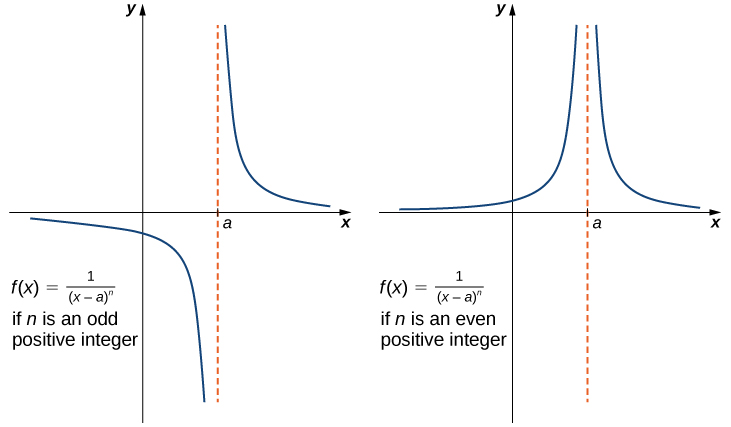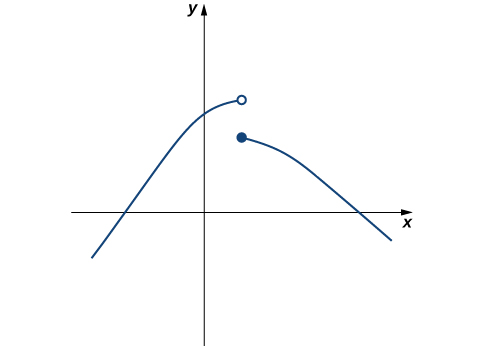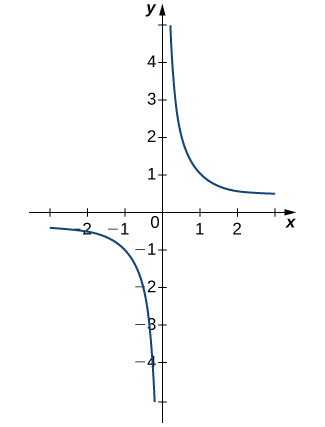Learning Outcomes
- Using correct notation, describe an infinite limit
- Define a vertical asymptote
Evaluating the limit of a function at a point or evaluating the limit of a function from the right and left at a point helps us to characterize the behavior of a function around a given value. As we shall see, we can also describe the behavior of functions that do not have finite limits.
We now turn our attention to [latex]h(x)=\frac{1}{(x-2)^2}[/latex]. From its graph we see that as the values of [latex]x[/latex] approach 2, the values of [latex]h(x)=\frac{1}{(x-2)^2}[/latex] become larger and larger and, in fact, become infinite. Mathematically, we say that the limit of [latex]h(x)[/latex] as [latex]x[/latex] approaches 2 is positive infinity. Symbolically, we express this idea as
More generally, we define infinite limits as follows:
Definition
We define three types of infinite limits.
Infinite limits from the left: Let [latex]f(x)[/latex] be a function defined at all values in an open interval of the form [latex](b,a)[/latex].
- If the values of [latex]f(x)[/latex] increase without bound as the values of [latex]x[/latex] (where [latex]x<a[/latex]) approach the number [latex]a[/latex], then we say that the limit as [latex]x[/latex] approaches [latex]a[/latex] from the left is positive infinity and we write
[latex]\underset{x\to a^-}{\lim}f(x)=+\infty[/latex].
- If the values of [latex]f(x)[/latex] decrease without bound as the values of [latex]x[/latex] (where [latex]x<a[/latex]) approach the number [latex]a[/latex], then we say that the limit as [latex]x[/latex] approaches [latex]a[/latex] from the left is negative infinity and we write
[latex]\underset{x\to a^-}{\lim}f(x)=−\infty[/latex].
Infinite limits from the right: Let [latex]f(x)[/latex] be a function defined at all values in an open interval of the form [latex](a,c)[/latex].
- If the values of [latex]f(x)[/latex] increase without bound as the values of [latex]x[/latex] (where [latex]x>a[/latex]) approach the number [latex]a[/latex], then we say that the limit as [latex]x[/latex] approaches [latex]a[/latex] from the right is positive infinity and we write
[latex]\underset{x\to a^+}{\lim}f(x)=+\infty[/latex].
- If the values of [latex]f(x)[/latex] decrease without bound as the values of [latex]x[/latex] (where [latex]x>a[/latex]) approach the number [latex]a[/latex], then we say that the limit as [latex]x[/latex] approaches [latex]a[/latex] from the right is negative infinity and we write
[latex]\underset{x\to a^+}{\lim}f(x)=−\infty[/latex].
Two-sided infinite limit: Let [latex]f(x)[/latex] be defined for all [latex]x\ne a[/latex] in an open interval containing [latex]a[/latex].
- If the values of [latex]f(x)[/latex] increase without bound as the values of [latex]x[/latex] (where [latex]x\ne a[/latex]) approach the number [latex]a[/latex], then we say that the limit as [latex]x[/latex] approaches [latex]a[/latex] is positive infinity and we write
[latex]\underset{x\to a}{\lim}f(x)=+\infty[/latex].
- If the values of [latex]f(x)[/latex] decrease without bound as the values of [latex]x[/latex] (where [latex]x\ne a[/latex]) approach the number [latex]a[/latex], then we say that the limit as [latex]x[/latex] approaches [latex]a[/latex] is negative infinity and we write
[latex]\underset{x\to a}{\lim}f(x)=−\infty[/latex].
Try It
It is important to understand that when we write statements such as [latex]\underset{x\to a}{\lim}f(x)=+\infty [/latex] or [latex]\underset{x\to a}{\lim}f(x)=−\infty [/latex] we are describing the behavior of the function, as we have just defined it. We are not asserting that a limit exists. For the limit of a function [latex]f(x)[/latex] to exist at [latex]a[/latex], it must approach a real number [latex]L[/latex] as [latex]x[/latex] approaches [latex]a[/latex]. That said, if, for example, [latex]\underset{x\to a}{\lim}f(x)=+\infty[/latex], we always write [latex]\underset{x\to a}{\lim}f(x)=+\infty [/latex] rather than [latex]\underset{x\to a}{\lim}f(x)[/latex] DNE.
Example: Recognizing an Infinite Limit
Evaluate each of the following limits, if possible. Use a table of functional values and graph [latex]f(x)=1/x[/latex] to confirm your conclusion.
- [latex]\underset{x\to 0^-}{\lim}\frac{1}{x}[/latex]
- [latex]\underset{x\to 0^+}{\lim}\frac{1}{x}[/latex]
- [latex]\underset{x\to 0}{\lim}\frac{1}{x}[/latex]
Try It
Evaluate each of the following limits, if possible. Use a table of functional values and graph [latex]f(x)=\dfrac{1}{x^2}[/latex] to confirm your conclusion.
- [latex]\underset{x\to 0^-}{\lim}\frac{1}{x^2}[/latex]
- [latex]\underset{x\to 0^+}{\lim}\frac{1}{x^2}[/latex]
- [latex]\underset{x\to 0}{\lim}\frac{1}{x^2}[/latex]
It is useful to point out that functions of the form [latex]f(x)=\dfrac{1}{(x-a)^n}[/latex], where [latex]n[/latex] is a positive integer, have infinite limits as [latex]x[/latex] approaches [latex]a[/latex] from either the left or right (Figure 9). These limits are summarized below the graphs.

Figure 9. The function [latex]f(x)=1/(x-a)^n[/latex] has infinite limits at [latex]a[/latex].
Infinite Limits from Positive Integers
If [latex]n[/latex] is a positive even integer, then
If [latex]n[/latex] is a positive odd integer, then
and
We should also point out that in the graphs of [latex]f(x)=\dfrac{1}{(x-a)^n}[/latex], points on the graph having [latex]x[/latex]-coordinates very near to [latex]a[/latex] are very close to the vertical line [latex]x=a[/latex]. That is, as [latex]x[/latex] approaches [latex]a[/latex], the points on the graph of [latex]f(x)[/latex] are closer to the line [latex]x=a[/latex]. The line [latex]x=a[/latex] is called a vertical asymptote of the graph. We formally define a vertical asymptote as follows:
Definition
Let [latex]f(x)[/latex] be a function. If any of the following conditions hold, then the line [latex]x=a[/latex] is a vertical asymptote of [latex]f(x)[/latex]:
Example: Finding a Vertical Asymptote
Evaluate each of the following limits using the limits summarized under Figure 9. Identify any vertical asymptotes of the function [latex]f(x)=\dfrac{1}{(x+3)^4}[/latex].
- [latex]\underset{x\to -3^-}{\lim}\dfrac{1}{(x+3)^4}[/latex]
- [latex]\underset{x\to -3^+}{\lim}\dfrac{1}{(x+3)^4}[/latex]
- [latex]\underset{x\to -3}{\lim}\dfrac{1}{(x+3)^4}[/latex]
Watch the following video to see the more examples of finding a vertical asymptote.
Try It
Evaluate each of the following limits. Identify any vertical asymptotes of the function [latex]f(x)=\dfrac{1}{(x-2)^3}[/latex].
- [latex]\underset{x\to 2^-}{\lim}\dfrac{1}{(x-2)^3}[/latex]
- [latex]\underset{x\to 2^+}{\lim}\dfrac{1}{(x-2)^3}[/latex]
- [latex]\underset{x\to 2}{\lim}\dfrac{1}{(x-2)^3}[/latex]
In the next example, we put our knowledge of various types of limits to use to analyze the behavior of a function at several different points.
Example: Behavior of a Function at Different Points
Use the graph of [latex]f(x)[/latex] in Figure 10 to determine each of the following values:
- [latex]\underset{x\to -4^-}{\lim}f(x); \, \underset{x\to -4^+}{\lim}f(x); \, \underset{x\to -4}{\lim}f(x); \, f(-4)[/latex]
- [latex]\underset{x\to -2^-}{\lim}f(x); \, \underset{x\to -2^+}{\lim}f(x); \, \underset{x\to -2}{\lim}f(x); \, f(-2)[/latex]
- [latex]\underset{x\to 1^-}{\lim}f(x); \, \underset{x\to 1^+}{\lim}f(x); \, \underset{x\to 1}{\lim}f(x); \, f(1)[/latex]
![The graph of a function f(x) described by the above limits and values. There is a smooth curve for values below x=-2; at (-2, 3), there is an open circle. There is a smooth curve between (-2, 1] with a closed circle at (1,6). There is an open circle at (1,3), and a smooth curve stretching from there down asymptotically to negative infinity along x=3. The function also curves asymptotically along x=3 on the other side, also stretching to negative infinity. The function then changes concavity in the first quadrant around y=4.5 and continues up.](https://s3-us-west-2.amazonaws.com/courses-images/wp-content/uploads/sites/2332/2018/01/11202918/CNX_Calc_Figure_02_02_015.jpg)
Figure 10. The graph shows [latex]f(x)[/latex].
Watch the following video to see the worked solution to Example: Behavior of a Function at Different Points. Note this video also repeats the steps for x = 3.
Try It
Evaluate [latex]\underset{x\to 1}{\lim}f(x)[/latex] for [latex]f(x)[/latex] shown here:

Figure 11.

